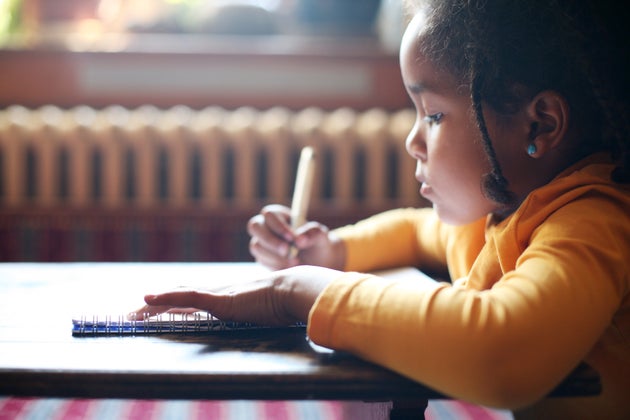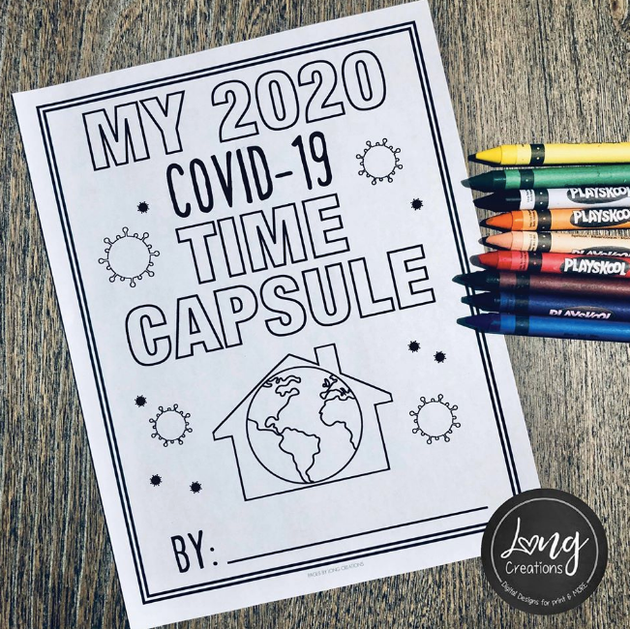
As the coronavirus pandemic picked up steam, Natalie Long wanted to find some ways for her family — particularly her 8-year-old daughter — to record what was going on in the world and in their hearts and minds.
So she created a Covid-19 time capsule workbook — that promptly went viral, much to her surprise.
Long, who runs an Etsy shop that sells printable art, has made a free PDF of the workbook available to anyone who wants to download it and who wants to help their children mark this moment in their lives. One page in the time capsule asks kids to write down how they’re feeling; another prompts them to write a letter to themselves.
“I’m so thankful it is helping others in this time, working through things in a ‘fun’ way … and [giving them] a way to document their thoughts and feelings for their future selves,” Long told HuffPost.
Inspired by her project — and in recognition of the fact that so many children are having a tough time emotionally right now — we asked our brilliant HuffPost Parents community for the activities and strategies we’re using at home to get our kiddos to open up.
Here are five tactics you’re trying that seem to really work:
1. Write a family newspaper.
HuffPost Parents reader Andrea says her family “publishes” a weekly newspaper. They post it to Facebook and also email it to their kids’ teachers, though you and your kids can obviously share publicly (or not!) in whatever way feels right to you.
What’s neat about Andrea’s family “newspaper” is that it doesn’t just include stories about what her family has been up to in the past week; it also has an op-ed section. And that’s where the kids can really dig into their emotional experiences.
“Each day, I interview the kids, often with questions pertaining to their feelings about our current situation,” Andrea said. “Occasionally they don’t feel like sharing, but on those days they like to interview me — and their questions for me are just as revealing and indicative of their feelings as their answers.”
2. Use their pretend play as a jumping-off point.
HuffPost Parents reader Heather says she has been making a real effort to tune into her 4-year-old’s play, using it as kind of a stealth opportunity to work through any anxieties he’s feeling.
“For a while after isolation started, he would talk about a monster that would make him sick and wanted to kill him,” Heather said. “We talked about how monsters can be scary, but if we keep ourselves safe it can help us fight monsters off. Later, he was pretending his friends wouldn’t come play with him. While still playing, I explained that his friends were not going to anyone’s house, that everyone was staying home — not just him.”
It’s a powerful approach, because play is an essential aspect of childhood development and an important ways for parents and kids to bond.

3. Get in the habit of offering a simple, consistent prompt.
For HuffPost Parents reader Jessica, getting her three kids (ages 3, 6 and 7) to open up about Covid-19 means sticking with a simple habit they’ve already developed: Asking them to name one good thing from their day, as well as one bad or challenging thing.
“Each person talks about their day by identifying one thing they celebrated and one thing they hoped would get better,” Jessica said. “Many angles of dealing with the pandemic have come up this way.” She noted that her kids especially respond to being given the chance to open up about their feelings, knowing that everyone in their family is really listening.
Even if that particular prompt doesn’t work for your family, it can help to find one that does. My own 5-year-old hates the high/low point prompt (“I DON’T WANT TO DO THIS, MUUUM”), but he’s recently gotten very into check-ins on the “mood meter” — basically, a four-colour chart his teachers taught him about what he’s feeling at a particular moment in time.
4. Go first.
“My youngest doesn’t like to talk about her feelings. She’s very much a ‘keep-to-herself’ type of person,” said HuffPost Parents reader Rikki.
Her simple strategy for getting her daughter to open up? Deliberately talking about what she herself is feeling, particularly in terms of what she misses, what she can’t wait to do again and where she is emotionally on any given day.
“She then started to talk about how she was sad that she missed out on her school music program and how she felt like school was taken from her,” Rikki said. “I think by expressing my feelings, she felt it was OK to express hers.”
Indeed, child mental health experts stress that it’s really important for parents not to shy away from talking to their kids about what’s going on in the world and what they themselves are feeling. As the Child Mind Institute says: “Kids worry more when they’re kept in the dark.”
5. Try poetry.
“My 13-year-old’s teacher had some poetry assignments a couple of weeks ago. We were amazed by the poems he created,” said reader Rachael. “[He] expressed himself better than he could have verbally.”
There is definitely research suggesting poetry can help people tap into deep emotions, and teachers often speak to its ability to help kids explore hard-to-describe aspects of their lives. If you’re not sure where to start, just Google “poetry prompts for children” and see if anything comes up that appeals to your kiddo.
But if that isn’t your child’s thing, or they’re simply not there yet developmentally, simply giving them a journal can help. It’s a safe space for them to work through their feelings, and it could be an incredibly interesting record for them to have down the road.


